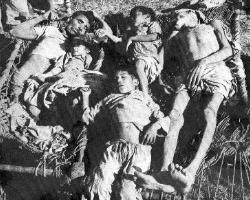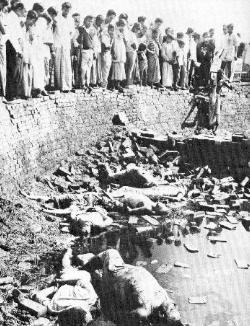| Home Introduction Bengali Literature Early History Islam in Bengal British Colony British Rule Sepoy (Soldiers) Rebellion in 1857 British Policy Muslim Nationalist movement Division of Bangla Muslim League Two Nations Concept Pakistan Period Political Discrimination Military Discrimination Language Movement Revolution of Ayub Khan Six Points Agartala Conspiracy Case Students 11 points Ayub Resigned & Yahya Came to Power General Election in 1970 Liberation War Declaration of Independent Government Formation Freedom Fighters Youth Spirit Surrender Genocide Atrocity Against Women How Many Died Criminals Photo Collections Links About Me (Resume) |
Pakistani
military placed for indiscriminate killing of innocent people, wide
scale destruction of villages, raping of women and looting and plunder.
By playing up religious sentiments they tried to instigate the simple
unsophisticated Bengali Muslims to kill or drive out the Hindus who were
painted as pro-Indian. By playing similar sentiments they created some
auxiliary forces such as Al-Badr, Al-Shams and Razakars to collaborate
with the military in identifying and eliminating all those sympathized
with the war of liberation. The freedom fighters who were operating
behind the enemy lines were to be hunted down and delivered to the
military for torture and killing. So-called peace committees composed of
collaborators were set up at different places to show that normalcy
prevailed. The
repression grew in scale and intensity as the Pakistani military junta
watched the freedom fighters grow in strength and achieve one success
after another. To hoodwink the international community, it launched a
worldwide campaign to paint the liberation war was rebellion against the
sovereignty of Pakistan and that their arch enemy India was behind all
this. The fact that about 10 million Bengalis had fled to India to
escape the military repression was depicted as India’s own game to
draw international sympathy. However, the truth about the character of
the liberation war and the atrocities committed by the military became
known to the wider world through independent reports by foreign
journalists and dispatches sent home by the diplomatic community in
Dhaka. About the crackdown of March 25, Simon Dring’s report to the
Daily Telegraph of London smuggled out of Dhaka and published on March
30 was one of many such reports. It said; ‘An
estimated three battalions of troops were used in the attacked on
Dhaka-one of armored, one of artillery and one of infantry. They started
leaving their barracks shortly before 10 pm. By 11, firing had broken
out and the people who started to erect makeshift barricade overturned
cars, tree stumps, furniture, concrete piping became early casualties. ‘Sheikh
Mujibur was warned by telephone that something was happening but he
refused to leave his house. "If I go into hiding they will burn the
whole of Dhaka to find me," he told an aide who escaped arrest. ‘The
students were also warned, but those who were still around later said
that most of them thought they would only be arrested. Led by American
supplied M-24 World War II tanks, one column of troops sped to Dhaka
University shortly after midnight. Troops took over the British Council
Library and used it as firebase from which to shell nearby dormitory
areas. ‘Caught
completely by surprise some 200 students were killed in Iqbal Hall,
headquarters of the militantly anti-government students’ union. The
military removed many of the bodies, but the 30 bodies still there could
never have accounted for all the blood in the corridors of Iqbal Hall. The
war against the Bengali population proceeded in classic genocidal
fashion. According to Anthony Mascarenhas, "There is no doubt
whatsoever about the targets of the genocide". Mascarenhas's
summary makes clear the linkages between gender and social class (the
"intellectuals," "professors," "teachers,"
"office bearers," and -- obviously -- "militarymen"
can all be expected to be overwhelmingly if not exclusively male,
although in many cases their families died or fell victim to other
atrocities alongside them). In this respect, the Bangladesh events can
be classed as a combined gendercide and elitocide, with both strategies
overwhelmingly targeting males for the most annihilatory excesses.
Robert
Payne describes scenes of systematic mass slaughter around Dhaka that,
while not explicitly "gendered" in his account, bear every
hallmark of classic gender-selective roundups and gendercidal slaughters
of non-combatant men:
|

